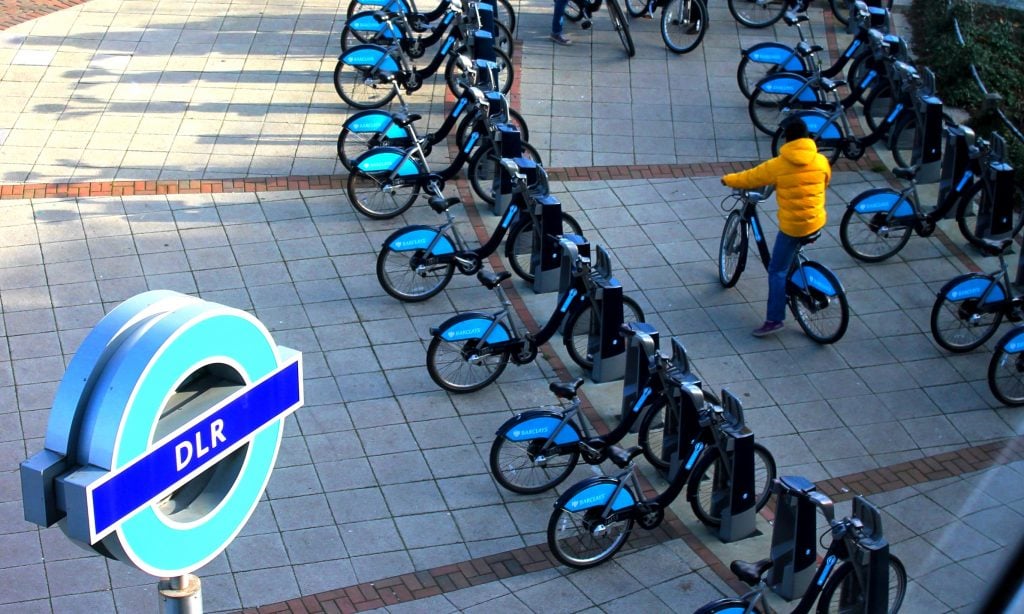A hot topic being discussed around the world is urban cycling and how cities are adapting to bikers and even fostering vibrant bike cultures.

During a trip to Copenhagen, I had the pleasure of meeting Mikael Colville-Andersen, Urban Mobility Expert, CEO of Copenhagenize Design Co. and creator of the popular Cycle Chic blog.

Above photo of Mikael Colville-Andersen. Photo courtesy of Erika Huffman.
As one of the world’s most influential people in the movement to promote cycling around the globe, I wanted to pick his brain on what makes a city bike-friendly and how non-bike-friendly cities can improve (as well as his opinion on helmet promotion and how to look stylish while riding). Read on to hear what he had to say:
1. Your transportation consulting firm, Copenhagenize, created a measurement for the world’s most bike-friendly cities. What are some of the things cities like Amsterdam, Copenhagen and Utrecht are doing differently than other cities to get themselves to the top of this list?
The leading bicycle cities have simply taken the bicycle seriously as a transport form in their urban planning. It’s not regarded as a sub-cultural sport/recreational activity. It’s a serious way to get around a city. What is more interesting on the Copenhagenize Index is the cities that have gone from zeroes to heroes in only 5 or 6 years. Bordeaux, Dublin, Paris, Barcelona, Seville, for example. There were no bicycles left in those cities back in 2006. Now they are poster children for Emerging Bicycle Cities. Seville went from 0.2% modal share for bicycles to 7%. The same in Dublin.
Danish and Dutch cities quietly rebuilt their bicycle cultures over the past four decades. Slow and steady. But now we’re seeing cities doing it in 5 years. THIS is interesting. It shows what is possible.
2. Many of the cities that make it into the top 10 of the world’s most bike-friendly cities are in Europe. Why do you think this is?
Again, European cities take the bicycle seriously as transport. Every city in the world was once bicycle-friendly. Even Los Angeles had 20% modal share for bicycles in 1900. European cities see bicycle traffic as a solution to many of the ailments that cities suffer; congestion, pollution, poor public health. Many urban planners approach it logically and rationally.
3. In your personal opinion, what is the cycling capital of the world and why?
I’m going with Copenhagen. Amsterdam is fantastic and I love cycling there. The city is, however, too unique in its layout to be a serious inspiration to other cities in the world. In Copenhagen, most of the city outside the medieval city center is a 20th invention. The streets are similar to many cities in North America. Motorways approach from three directions. And yet the bicycle is the primary transport form. Planners who visit can squint their eyes and see how their own city would look with well over a third of the traffic on bicycles. Copenhagen is innovative, taking things to the next level in order to increase cycling levels.
4. You’ve been known to often speak about how subcultures can affect how bike-friendly a city is. Can you explain?
The cycling sub-cultures are a hurdle to mainstreaming bicycle culture, even though that may sound counter-intuitive. The nature of sub-cultures is insular. They are not often keen to see their beloved hobby/activity become mainstream. Much bicycle advocacy in North America is done by the “avid” cyclists. They have a sense of ownership over all things bicycle. They don’t, however, realize that the 99% doesn’t want what they want. They don’t want over-complication with gear and fancy bicycles. People – Citizen Cyclists I call them – just want to be able to ride a bicycle safely and conveniently.
Having avid cyclists doing the talking about bicycles is like having race walkers doing the talking about pedestrian-friendly cities. It doesn’t work. It’s two different things. The success of the aforementioned “zero to hero” cities is also due in part to the fact that there were no cycling sub-cultures. They leapt deftly from no bicycles to Citizen Cyclists. The citizens didn’t have to feel like they needed “membership” in a sub-culture in order to ride. They just rode.
5. One of the most controversial topics you’ve discussed in your public speeches is the use of helmets when riding a bike. How do you think promoting helmets affects cycling culture?
We know that in every region in the world where helmets have been promoted or, even worse, legislated, cycling levels drop. A message is sent that cycling is dangerous, which it isn’t even in cities without modern, intelligent bicycle infrastructure. There is no conclusive scientific evidence from anywhere in the world that helmets work — except in scaring people off of bicycles. A catastrophe in an age of obesity and lifestyle illnesses.
In Europe the science of helmets is taken seriously. In North America, however, it is anecdotes that rule the roost, with little respect for science. Most cycling NGOs in Europe don’t even promote helmets. Even the highest levels of European Union government have warned against helmet promotion and legislation.
6. Do you think helmets should be promoted in big cities with little biking infrastructure?
A helmet is only designed to protect the head from non-life threatening impacts in solo accidents under 12 miles per hour. They’re not even designed for impact with automobiles. What would be rational would be promoting motorist helmets. They have actually been invented: www.motoringhelmet.com.
With 35,000 people killed in cars each year in America, this would be intelligent.
7. What do you think is the most important step for cities to take when looking to become more bike-friendly?
Separated infrastructure based on Best Practice is the key. Traffic calming measures like 20 miles per hour zones in cities are vital, as well. Now that 500 cities around the world have bike share systems, we know that they have a fantastic transformational effect on reestablishing the bicycle on the urban landscape. Cities should also take established Best Practice seriously.
What’s up with those bike lanes on the LEFT side of parked cars in North American cities? Expecting cyclists to ride between the door zone and moving traffic? Stupid. Fire the engineers who put them in. Cycle tracks should follow the curb, as they have for a century around the world. And sharrows? Please. Cities shouldn’t even be allowed to include sharrows when calculating the distance of their bicycle infrastructure.
Best Practice is established. Cities should just copy/paste from places that know how to do it and that have proved it works.

Photo courtesy of Les Haines.
8. What’s one thing you think is holding cities who aren’t in the top 10 bike-friendly cities back?
Lack of political will and/or lack of educated traffic engineers.
9. What’s your response to those who say they can’t commute around their city by bike because there aren’t any bike lanes?
I understand them. The 99% don’t want to run with the bulls. They just want to ride safely and conveniently. That’s why Copenhageners ride. The majority – 56% – say they ride because it’s easy and fast. Only 6% ride because it’s inexpensive. Only 1% ride for environmental reasons. With that said, it’s important to bust the myth that cycling is dangerous. A myth that persists in North America. Statistically, it’s safe.
10. You’re also well-known for your Cycle Chic blog, a site that shows Copenhagen’s most stylish cyclists and has inspired other cities to start their own Cycle Chic blogs. What do you think makes Copenhagen locals such fashionable cyclists?
Copenhageners are a fashionable crowd. They just happen to ride bicycles around their city. Cycle Chic is just a place that shows all the beauty and diversity of our Citizen Cyclists. And what is possible in every city on the planet.
What do you think we can do to create more bike-friendly cities? Are there any cities that you think are great/not so great for cyclists? Please share in the comments below.
Top photo credit: photo courtesy of Dustin Gaffke.

Jessica Festa is the editor of the travel sites Jessie on a Journey (http://jessieonajourney.com) and Epicure & Culture (http://epicureandculture.com). Along with blogging at We Blog The World, her byline has appeared in publications like Huffington Post, Gadling, Fodor’s, Travel + Escape, Matador, Viator, The Culture-Ist and many others. After getting her BA/MA in Communication from the State University of New York at Albany, she realized she wasn’t really to stop backpacking and made travel her full time job. Some of her most memorable experiences include studying abroad in Sydney, teaching English in Thailand, doing orphanage work in Ghana, hiking her way through South America and traveling solo through Europe. She has a passion for backpacking, adventure, hiking, wine and getting off the beaten path.








